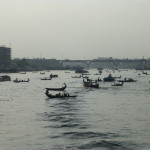
Tourism has come slowly to Bangladesh. It’s a poor place, with little to invest in enticing visitors or building tourist resources. Now it principally attracts the adventurous, curious and backpacker set.
The country is often bypassed as a less appealing cousin to India. Its major national park, for example, Sunderbans, is an enchanting delta area created by the Ganges as it reaches the sea. But it’s shared with India. Bangladesh’s portion of the rich delta may be larger in area, but India gets a much larger share of visitors.
Bangladesh’s economic prospects and interest among tourists are growing slowly. Malls and appealing hotels have emerged in Dhaka, the capital, and other major towns. Huge contemporary textile plants pop up in unexpected places.
In the meantime, traveler resources are sufficient to traipse about. But navigating the country demands a good deal of commitment and patience from the typical traveler.
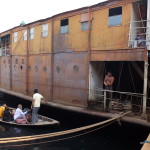
For example, to buy a ticket to the Rocket river ferry from Dhaka, a recommendation on every guide’s overview of the country, you must go to the ferry company offices in the city center, pay a little extra as bribe to get served, and purchase the ticket. Our hotel offered to do this for us and saved us hours of effort.
It’s just as tough, we found, booking a train back to Dhaka from Srinagar, a locus of tourist interest in the north, touted for its tea plantations, bike trails and waterways. We couldn’t just go to the local train station to secure a reserved seat, but had to arrange for someone to make the booking back in Dhaka. There apparently was some mysterious allocation system for seat purchase at outlying stations, but all still had to be sorted out with the central station.
And then there are the roads, which rival many of India’s in impassability.
All of this hassle makes visiting more difficult, but hardly impossible. The people help smooth out the rough spots, so friendly and ready to do their utmost for you. It may take a while, but things will surely improve with the country’s fortunes.
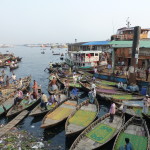
Still the state of things was pretty apparent from the circuitous route we took, starting with the Rocket paddle steamer along the intertwined riverways of southern Bangladesh, driving through the ancient monuments of Bagerhat by car, and then taking the train from the town of Khulna back to Dhaka.
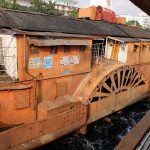
After you have secured a ticket to the Rocket, you face the challenge of reaching the boat. Arrival is far from ceremonious or elegant. The boat is hidden down a passageway cutting through drab street stalls to the riverside. There you find the Buriganga River, a fetid, trash-strewn and greasy waterway here. At the river’s edge, you must walk the planks, a series of wobbly boards connecting several other ferries moored at the quay to the Rocket itself.
Most of these ferries are standard class vessels that make third-class travel look elegant, but they efficiently carry people around a country that is truly water-logged. Lakes and rivers dominate the landscape, eventually usurping almost all land in the watery delta of the Sunderbans. Travel by water is often a necessity.
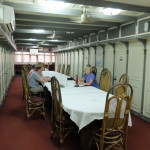
The Rocket steamer was named for its speed compared to other transport 100 years ago, though it is now rather the tortoise than the hare on the river. It’s a throwback to a time when the British still lived the high life as colonial leaders. These paddle steamers were the classy way to travel by boat, like an Orient Express for water. Presidents and MPs traveled comfortably on them. The ones still working date from the 20s – now powered by diesel, not by steam.
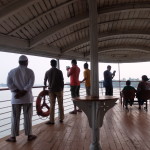
The Rocket’s wooden decks may bear the imprint of decades of the well-heeled, but the exterior is what you might call a rust-bucket. You need to have some faith in the longevity of the boat. But the prospect of a two-day journey brightens a lot once you enter the dining hall, with its long wood table spread with a large white tablecloth. The table nearly fills the room, ready, it seems, for dozens of travelers. It all appears neat, clean and organized, with the casually dressed staff ready to get tea and help you settle in. The food they prepared later might have been unexceptional, but it was edible and varied at least.
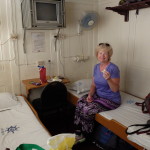
On each side of the table, about ten doors for the bedroom compartments line the walls. Inside, the bedrooms may have become more drab over time, with layers and layers of white paint trying to perk up the walls, but they’re surprisingly comfortable. With two twin beds, shelf space, fans to cut the heat, tricky but functioning wall lights, another door directly onto the outer deck, plus a wash basin – all akin to a bedroom compartment on trains – you have everything you need in a compact space.
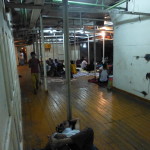
We did not see the second class section, but even the Rocket offered a steerage class in the central part of our deck. There over a hundred people set up temporary living space for themselves with mats and blankets, chatted leisurely on the deck till late, then slept as well as they could in the humid open air. Hawkers sold Bangladeshi romance novels and other goods. A few enterprising young men climbed over barriers to our section to see how the other class lived, but caused no problems.
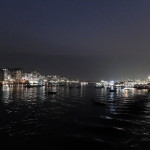
We settled in and began to enjoy ourselves. As darkness softly wrapped the landscape, the dim shore lights blinked on and the bright beams of the other, swifter ferries passed us by. The river became cooler. We settled into a languid mood, a pleasant contrast to more hurried forms of transport.
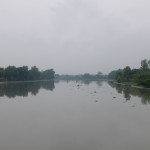
And we slept soundly, with only the thub-thub of the paddle wheel and engine to mark the rhythm of our progress. In the hazy light the next morning, the mostly bare river banks, with their tiny fishing villages, felt ancient and welcoming. The tranquil river had turned almost beautiful.
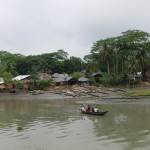
Just a short car ride from the last port on our river trip were the 15th century mosques. mausoleums and ruins of Bagerhat, a UNESCO World Heritage site. Known then as Khalifatabad, this lost city was buried in forest growth and dirt for hundreds of years until over 50 structures were uncovered again.
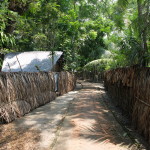
In the outlying area, we walked to some village paths lined with fences made of palm fronds. In the center of Bagerhat, city streets linked a dozen major mosques and tombs, with various numbers of domes on their roofs (and corresponding interior sections). The largest bubbled over with 60 domes on top. They were engaging, but still poorly maintained and presented compared to similar Mughal-era monuments in India.
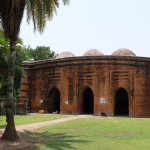
The return to Dhaka by train began after a night’s stay at a pleasant hotel in nearby Khulna. The train station was a lot easier to handle than those in India, with controlled access to prevent throngs of people hanging about and a much more orderly loading process. The train itself, however, looked like it had been decommissioned by India Rail, whacked extensively with sledgehammers, and then been put into service for the Bangladeshis.
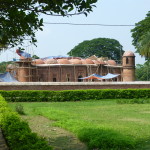
Inside second class, the windows were tough to see through, largely stained and cracked, with some actual holes made by tossed rocks. Many seats did not lean. Our assigned seats were separated so we had to trade with friendly passengers. The row we ended up in was broken: one seat back was stuck leaning permanently at 45 degrees; another was askew. No trays; no power source even at the back circuit panel that seemed to offer it. Air-conditioning didn’t really work.
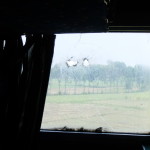
Otherwise, it was relatively clean. The seats were beat up, ragged, but not offensive. The aisles had been swabbed, as were the toilets, which were well stocked at least at the start.
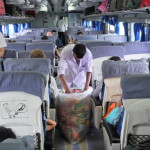
The first-class compartments in the adjacent car were the nicest part of the train, and we wished we had been able to book one. Each accommodated 4 to 6 people sitting or 4 lying down in the surprisingly wide beds. We squatted in one for as long as we could, recharging our phones with its available power plugs. After a few hours, that party ended, as a large group got on and claimed their space. We returned to our assigned seats back in second class.
The compensation for the lesser class section, though, was the interesting people…and the constant activity. When we started hunting for an available compartment, an older Bangladeshi gentlemen who knew English tried to help us. And the word gentleman is not an idle one. He applied a respectful attitude toward the young assistant stewards on board, and followed this with an insistent, but ingratiating, questioning of the main steward. He was only moderately successful at helping us, but his style alone should have done the trick. For much of the train ride he sat in one of our broken seats next to a much younger bank lending officer on the way to Dhaka for training, clearly eager to learn about the banker’s life and share observations.
The steward himself was a blunt, burly man who seemed perpetually busy and harassed. He was the enforcer or bouncer, patrolling the cars to unseat people who had snuck into a higher class…and was the one who evicted us from our temporary compartment.
One source of his irritability perhaps was the indolent conductor who seemed not to have an idea what seating was taken or not. He kept consulting his chart, but was indifferent to all the switching of seats within the car. He somehow knew that all the seats and compartments would eventually be taken, but left it up to the enforcer to keep things in control.
The young steward assistants kept in constant motion, ferrying huge sacks of chips and candies along the aisles, or fetching chai tea, soda and snacks for the passengers. At stops, they were joined by local newpaper hawkers fruitlessly peddling dailies until the train was ready to depart.
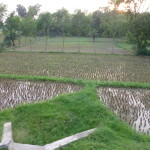
The passengers were mainly middle class Bangladeshis, aside from three Scandinavians we had already befriended on the Rocket trip. Most of the people had come in family groups, with a few singles and couples. Largely they all kept to themselves, though the young children got rambunctious every so often. All very civilized. Like us, many groups had brought their own food in plastic bins for nourishment. Others made quick hops off the train at the larger stations to snag some street food there. As the trip wore on and the plastic bins emptied, the sack-laden stewards found plenty of sales.
In our car, there were many empty seats to start with, but the car gradually overfilled as we got closer to Dhaka. Some slipped in from other classes; others shifted seats in pursuit of one that felt better. With three hours to go, a large group got on and began a shouting match with the group that was occupying its assigned seats. That central allocation system had apparently broken down. Our bouncer seemed to give up on the whole thing.
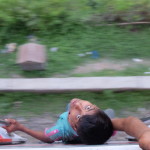
Many young men appeared in the jouncing space between train cars, staying cool in the open rather than overheated in a lower class car. One young man even rode perilously for a while hanging on the side of the fast moving train. Fortunately he soon was hauled onto the car transom, rewarded for his bravado with a safe haven till the end of the trip.
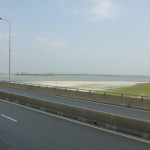
Even with all this entertainment, it was a long, long 10 hour ride despite steady progress by the train and no blockages. The problem is that the train must take a crazy route: to go northeast to Dhaka, we had to go west-northwest first, continue on much farther north than Dhaka, then cut east and finally head back south.
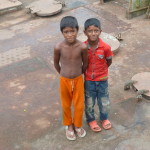
A more direct route would take only half the time. Why the inefficient trip? There is only one train bridge nearly 6 kilometers wide, built in the 1990s across the Jamuna, a river which splits the watery country in two and joins up with the Ganges.
Maybe with the arrival of a few more tourist dollars in the years ahead, such inconveniences will go away. But, on the Rocket or along the rails in the meantime – as with travel in other parts of the country – visitors to Bangladesh need to bring with them a good deal of patience and a spirit of adventure.
(Also, for more pictures from Bangladesh, CLICK HERE to view the slideshow at the end of the Bangladesh itinerary page.)


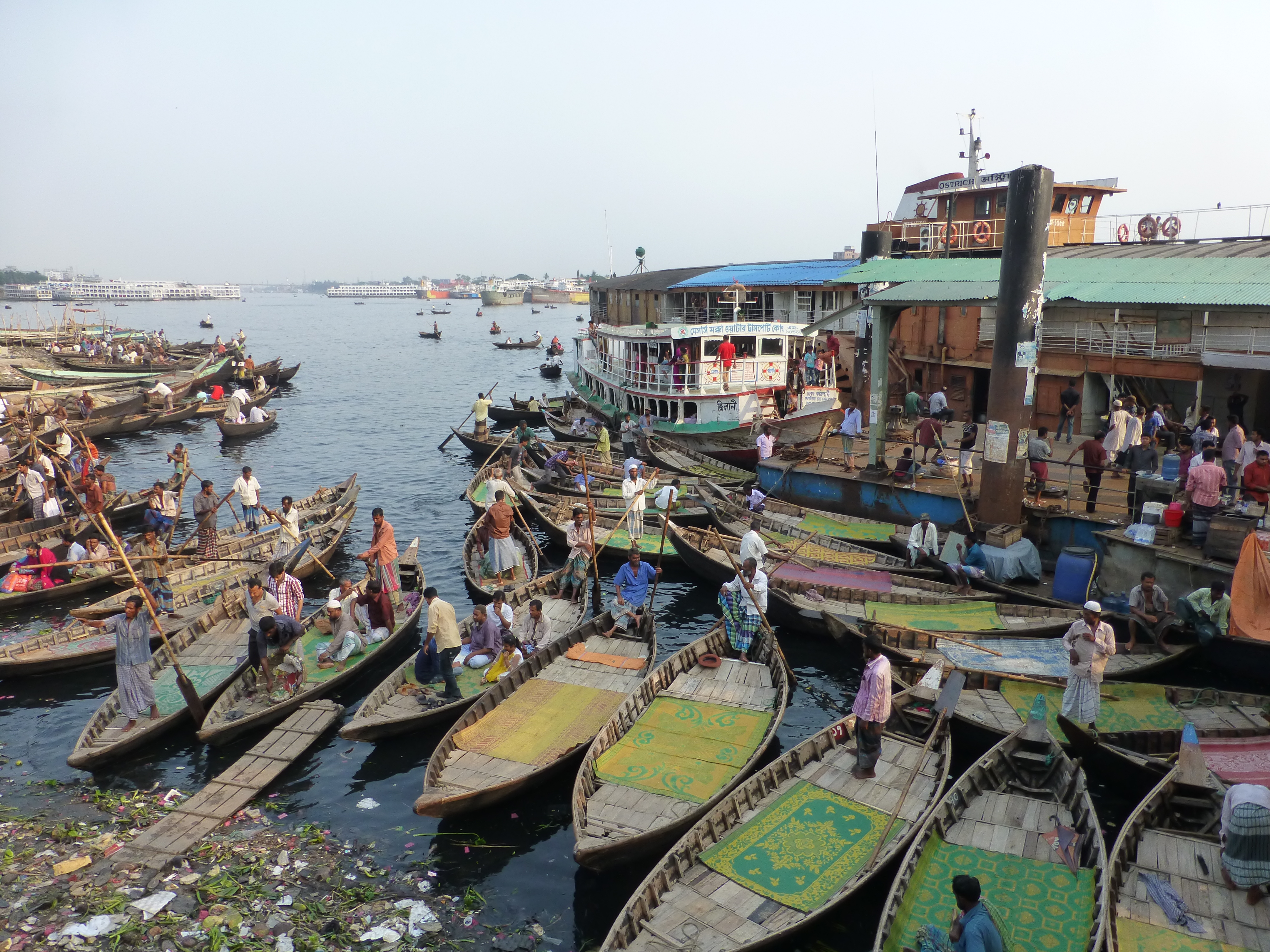
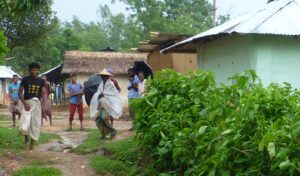
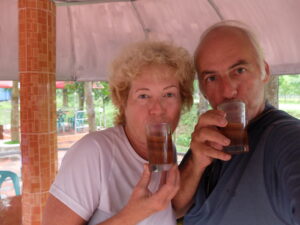
A little late to this game, but I love THE ROCKET – quite the nickname. It looks like a 1976 Chevy Nova that’s been left in an empty lot!
You’re disgracing an old Chevy Nova with this observation!
PS Love the picture of the kid hanging onto the train…
Enjoyed reading your Bangladesh travel story!
It is true that there is no tourism in Bangladesh, and it is always overlooked by its big neighbor. But it is an interesting country for the adventurous tourists, and has many things to see.
There are three UNESCO World Heritage sites in Bangladesh and many other interesting places to visit. They could easily fill at least one full month. Problem is, there is not much information about it anywhere.